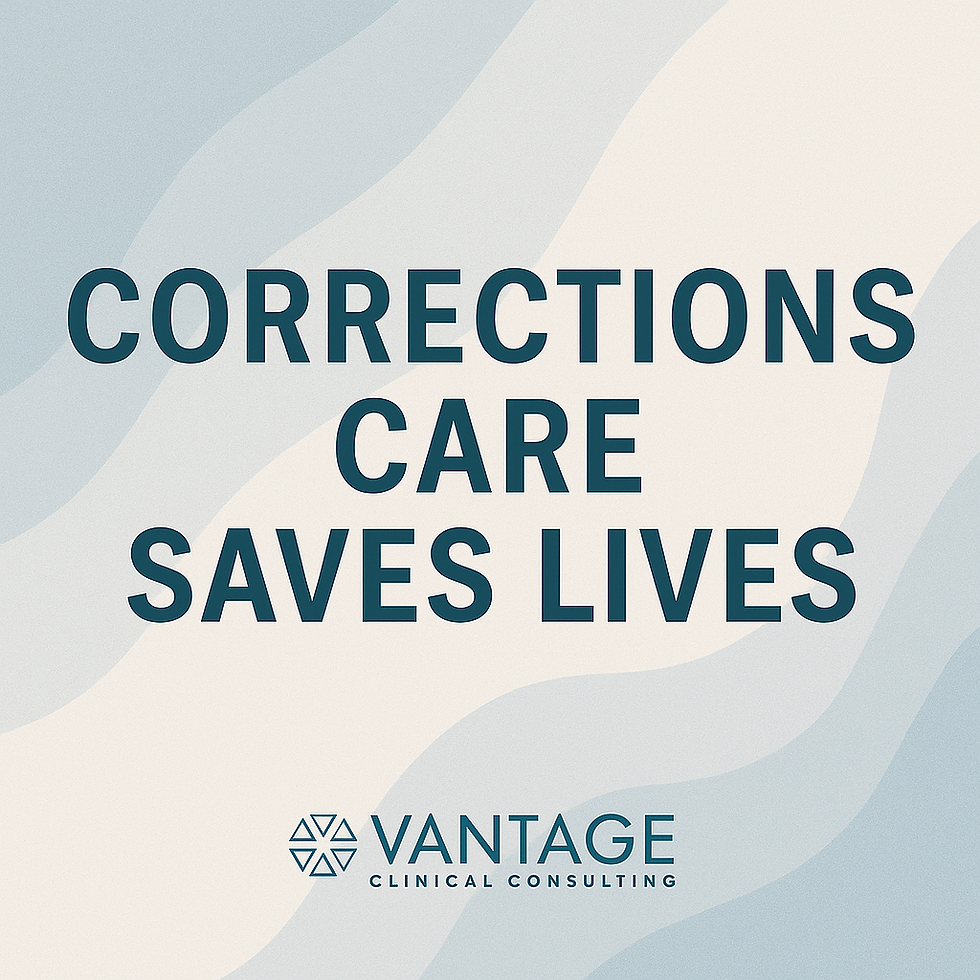Vantage Policy Watch Week of August 18, 2025
- jameliahand
- Aug 14
- 3 min read
Updated: Aug 15
Substance Use, Mental Health, and Corrections
By: Jamelia Hand MHS CADC CODP I
Across the country, critical shifts are unfolding in behavioral health policy, corrections care, and the systems that link them. From civil commitment laws to school-based mental health screening, and from in-custody care disputes to funding pressures, each change carries ripple effects for the frontlines. This week’s developments highlight a single truth: without continuity, even well-intentioned policies can fracture the pathways that keep people safe, supported, and engaged in care.

Civil Commitment Expansion in Oregon
Oregon has passed a new law lowering the threshold for involuntary psychiatric care. Proponents frame the change as a way to enhance public safety, while advocates warn it risks overwhelming already strained inpatient systems and infringing on civil liberties.
If inpatient admissions increase without matching investments in discharge planning and community step-down programs, the result will be bottlenecks, fragmented care transitions, and an increased risk of relapse or readmission for those with co-occurring substance use disorders (SUD).
Illinois Prepares for Annual K–12 Mental Health Screenings
A statewide mandate requiring annual mental health screenings for all K–12 students will take effect in the 2027–2028 school year. While supporters see it as a step toward early identification, parents and privacy advocates are asking hard questions about consent, data security, and follow-up services.
The screenings will only make a difference if they lead to timely, supported connections to community care. Schools and behavioral health providers must align now on secure referral processes, family engagement strategies, and warm handoff protocols to avoid overwhelming an already stressed outpatient network.
Corrections Care Under Scrutiny
Wrongful Death Suit (New Mexico): CoreCivic’s Cibola County Correctional Center faces allegations of delayed mental health and medical response after an in-custody death.
Georgia Class Action — Gender-Affirming Care: A lawsuit challenges a state law ending gender-affirming care for incarcerated people, arguing that abrupt cessation of treatment carries serious mental health risks.
These cases reinforce that correctional facilities (both public and private) must re-examine suicide prevention protocols, medication continuity plans, and crisis-response readiness. Gaps in these areas not only cost lives but also expose agencies to legal, reputational, and operational consequences.

Funding and Policy Backdrop
Medicaid cuts and increasing parity enforcement remain the backdrop against which these shifts are unfolding. Leaders in behavioral health warn that without strong outcomes data to defend funding, prevention and recovery services will be the first to feel the pinch. For substance use and mental health providers, this means tightening data tracking, proving impact, and diversifying revenue streams now, not after funding reductions hit.
The Vantage Take
The throughline this week is clear: continuity is the metric that matters most. Whether a person is leaving a correctional facility, being referred after a school screening, or transitioning from inpatient psychiatric care, every disruption in care is a risk point.
Here’s what to prioritize right now:
Bridge Care Protocols: Same-day initiation for SUD/MH treatment, at least a 7-day medication supply at discharge, and documented follow-up within 72 hours.
Custody-to-Clinic Links: Formalize MOUs for MAT-in-custody programs and conduct joint crisis drills with corrections partners.
School-to-Clinic Playbooks: Establish clear criteria for referrals, data protections, and strategies to prevent waitlist overload after screenings.
Funding Resilience: Prepare for Medicaid volatility by expanding grant funding, leveraging pilot opportunities (like Hep-C elimination in SUD/SMI populations), and enhancing outcomes reporting systems.

The policies and lawsuits making headlines this week are more than just governance stories, they’re frontline realities waiting to happen. Every shift, whether in a statehouse, school district, or prison yard, can either strengthen or fracture the fragile chains of care that keep people safe and supported. Providers who act now to safeguard continuity, measure outcomes, and formalize partnerships will not only weather the changes, they’ll lead in setting the new standard for integrated, patient-centered behavioral health care.
Continuity over chaos isn’t just a slogan... It’s a survival strategy for our systems, our staff, and the communities we serve.
#VantagePolicyWatch #BehavioralHealth #SubstanceUseTreatment #MentalHealthCare #CorrectionsCare #HealthPolicy #Medicaid #ContinuityOfCare #ReentrySupport #SchoolMentalHealth #PatientCenteredCare


Comments